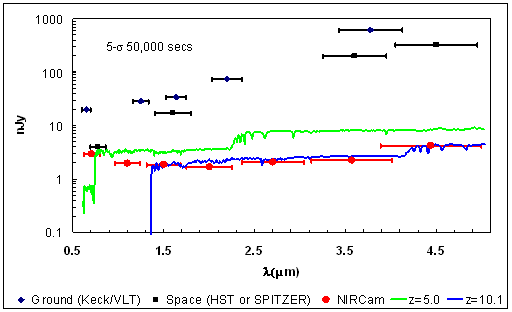Very High Redshift Galaxies
One of the greatest scientific discoveries of the 20th century was that the universe is expanding. The discovery came from the observation that all but the very closest galaxies in the universe appear to be moving away from Earth. This was done by measuring the displacement due to the Doppler effect of the spectroscopic lines of some common atoms within the spectra of these galaxies – such as hydrogen, oxygen, nitrogen, calcium, iron, and magnesium. This displacement is known as the redshift.
Because of the expansion of the universe, the farther a galaxy is away from us the larger the redshift. For very distant galaxies, the spectroscopic lines shift out of the visible wavelengths into the infrared, as can be seen with this galactic redshift simulator. Due to the finite speed of light, as we observe more distant galaxies we also look back in time. The Near Infrared Camera for JWST was designed specifically to detect galaxies at very large distances from us. NIRCam will be used as a time machine to see some of the universe’s youngest, most distant galaxies at several stages of their development, up to a few hundred million years since their formation. NIRCam’s sensitivity to very high redshift galaxy spectra is illustrated in the plot below:

This plot shows the spectrum of two galaxies: one, in green, at a redshift of five (z=5.0, 12.5 billion years in the past), and another, in blue, at a redshift of 10 (z=10.1, 13.2 billion years in the past). The red dots with bars represent the sensitivities of the NIRCam filters and their wavelength coverage between 0.5 and 4.5 microns. Compared to ground-based telescopes and the Spitzer Space Telescope, NIRCam will be able to measure much fainter galaxies.
Extragalactic Data Challenge
As JWST is readying for launch, the NIRCam team, in collaboration with the NIRSpec team, will be using simulated data to define their observational strategy, and to understand the selection effects that will be affecting data analysis. For more information, please visit the Extragalactic Data Challenge page.
Relevant Publications
Williams et al (2018), “The JWST Extragalactic Mock Catalog: Modeling Galaxy Populations from the UV through the Near-IR over 13 Billion Years of Cosmic History,” The Astrophysical Journal Supplement Series: NASA ADS
Gardner et al (2006), “The James Webb Space Telescope,” Space Science Review: Springer
